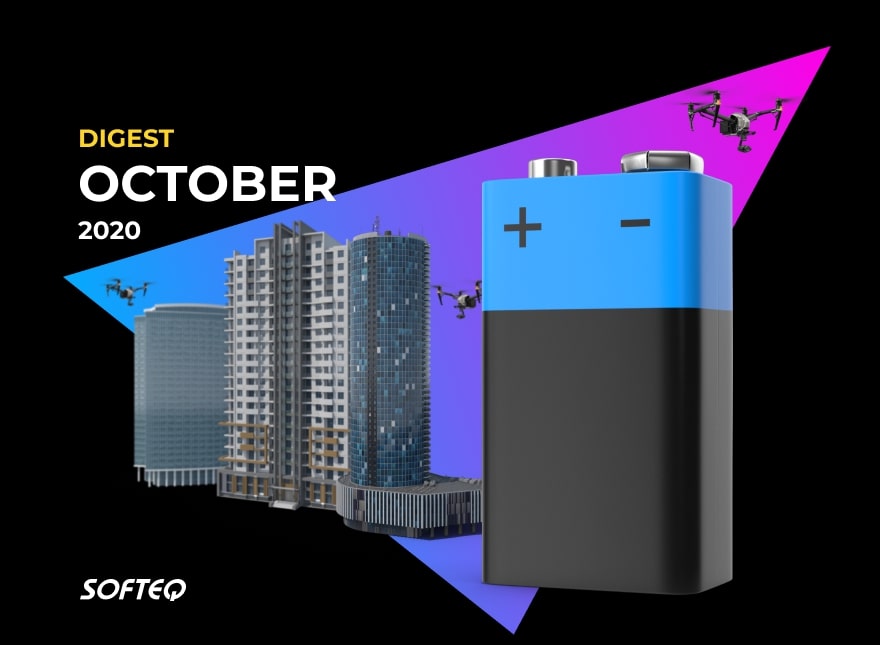Check out our latest blog article: From component to enterprise – modular robotics done right.
This is What Techies Talked about in October

In this issue of the Tech Digest: companies are seeing little ROI on AI investments, Gartner unveils its annual list of strategic technology trends, and IoT devices no longer need batteries and electronic components to collect and transmit data. All that and more in a 10-minute read.
Only 11% of companies that have deployed AI are seeing a sizable ROI
As more companies turn to technology to soften the pandemic’s economic blow, Artificial Intelligence is making headlines again. This year, corporate spending on AI systems may surpass $50 billion—but very few companies will actually see returns on their whooping investments. According to a recent study conducted by MIT Sloan Management Review and Boston Consulting Group, just 11% of companies that integrated Artificial Intelligence in their workflows have seen a sizeable return on their investments. Despite being a cold dose of realism amid the AI hype, the report also explains what business can do to start profiting from AI.
Gartner announces the top strategic technology trends for 2021
Earlier this week, Gartner published its annual list of strategic technology trends every company should explore in the coming year. The technologies that are trending up include distributed cloud services, advanced cybersecurity systems, and the Internet of Behaviors (IoB) among others. The concept that really stands out from the list is AI engineering—an approach that helps create, deploy, and manage AI solutions. As of now, only 53% of projects related to Artificial Intelligence and its subsets make it from prototypes to production. To implement AI at scale, companies need a healthy combination of DevOps, DataOps, and ModelOps practices—and qualified human resources, of course.
The Artificial Intelligence of Things (AIoT) becomes the new norm for IoT adopters
Across the globe, enterprises are reportedly using 5.8 billion connected devices and sensor nodes. By 2025, the amount of data generated by IoT endpoints could reach 74.9 zettabytes. How come only 17% of enterprise data is currently used for analytics? It turns out 42% of companies that use IoT cannot cope with the excessive amount of sensor data, while 25% of IoT pioneers lack data analytics capabilities. And what if we hand over the data analysis tasks that were previously performed by humans to AI algorithms? That’s what the Artificial Intelligence of Things (AIoT) is all about! Discover how your company could benefit from integrating Artificial Intelligence into IoT deployments—either in the cloud or on devices.
Facebook and Carnegie Mellon turn to Machine Learning to store and scale renewable energy
Alternative energy sources like solar, wind, and ocean tides generate up to 20% of all energy consumed in the United States and Europe. Renewables’ major drawback is that they produce energy at irregular intervals and require storage facilities to balance out power consumption between peak generation and demand. Without a technology overhaul, green energy penetration levels will fluctuate around 30%, with electricity costs rising significantly at the current adoption rate. Batteries have always been too expensive to scale. To store power harvested from alternative energy sources, we could potentially convert it into fuels like ethanol or hydrogen. For this, we need catalysts—i.e., substances that trigger chemical reactions. The discovery of these substances involves heavy computing and simulations, which take years to carry out. To solve this problem, Facebook has partnered with a research group from Carnegie Mellon’s Department of Chemical Engineering. The scientists created a Machine Learning model that helps discover suitable catalysts in mere hours.
Energy management information systems (EMIS) can save America $4 billion in building energy costs
In the United States, commercial and residential buildings account for 74% of all electricity use. 30% of this energy, however, is being wasted through inefficient climate control, unnecessary lighting, and leaving electronic devices on. When telecom giant Sprint installed energy management information systems at its headquarters at Kansas, it managed to reduce annual energy consumption by 4.7 million kilowatts, or $400,000 in energy bills. The EMIS solution, which incorporated smart sensors, meters, and data analytics software, was created in partnership with Berkeley Lab. According to Jessica Granderson, deputy of research programs for the Building Technology and Urban Systems Division at Berkeley Lab, property owners can implement EMIS solutions in every building across the country without breaking the bank. By giving buildings a digital overhaul, America could save $4 billion in annual energy costs while reducing their carbon footprint.
Artificial Intelligence emerges as a double-edged sword for cybersecurity
In September, a ransomware attack that hit the Universal Health Services (UHS) hospital chain has once again drawn public attention to healthcare IT security. What made this attack particularly alarming is that hackers utilized some form of Artificial Intelligence to automate and disguise malicious activities. But there are two sides to the AI coin. While cybercriminals can use smart algorithms to break into IT systems, security experts can harness Artificial Intelligence to defend them. Robust Intelligence, a startup founded by a Harvard professor and his former students, created a platform that uses Machine Learning models to detect and simulate over 100 types of cyberattacks. In the future, similar solutions could help healthcare organizations protect patient data and prevent cybercriminals from disrupting clinical workflows.
3D printed objects no longer need batteries and electronic components to capture data and connect to Wi-Fi
The Internet of Things concept has always revolved around collecting and sending environmental data to the cloud over wireless networks. For this, we needed electronic devices or non-electronic objects equipped with battery-powered sensors. But researchers from the University of Washington managed to create plastic objects that communicate with smartphones and other Wi-Fi devices without batteries or electronic components. Made out of 3D printed plastic with copper or graphene fillings, these objects transmit data by reflecting or not reflecting a router’s signal. The novel technology could be a welcome addition to Smart Home systems and point-of-care medical solutions: when plastic containers with pills or detergent need refilling, they can send alert notifications to a central hub and replenish supplies automatically.
